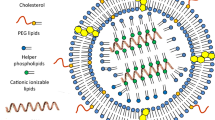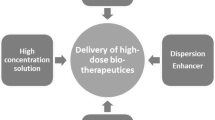Abstract
Human heat-shock protein 60 (HSP60) is an autoantigen involved in the pathogenesis of rheumatoid arthritis (RA). Epitopes derived from HSP60 can trigger activation of regulatory T cells (Treg). CIGB-814 is an altered peptide ligand (APL) derived from HSP60. In preclinical models, this peptide had anti-inflammatory effects and increased Treg. The results from phase I clinical trial indicated that CIGB-814 was safe and activated mechanisms associated with induction of tolerance. Biodistribution profile for inducers of tolerance is crucial for triggering its effects. The primary goal of this study in Lewis rats was to identify (1) the target organs of CIGB-814 and (2) the pharmacokinetics (PK) profile. 125I-CIGB-814 administered subcutaneously at three dose levels was distributed in the thyroid gland, but also at considerable levels to the stomach and small and large intestines. In addition, concentration of CIGB-814 was increased in lymph nodes (LNs) at 24 h, compared with 4-h post-administration. Small intestine and LNs are excellent sites for induction of tolerance, due to the characteristics of dendritic cells in these tissues. Maximum concentration of CIGB-814 in blood of Lewis rats at 0.5 to 1 h agrees with PK profile determined for patients. Altogether, these results support therapeutic possibilities of CIGB-814 for RA.



Similar content being viewed by others
References
Alberta GA, van der Zee R, Taams LS et al (2000) A self-Hsp60 peptide acts as a partial agonist inducing expression of B7-2 on mycobacterial hsp60-specific T cells: a possible mechanism for inhibitory T cell regulation of adjuvant arthritis. Int Immunol 12:1041–1050
Barberá A, Lorenzo N, van Kooten P, van Roon J, de Jager W, Prada D, Gómez J, Padrón G, van Eden W, Broere F, del Carmen Domínguez M (2016) APL1, an altered peptide ligand derived from human heat-shock protein 60, increases the frequency of Tregs and its suppressive capacity against antigen responding effector CD4+T cells from rheumatoid arthritis patients. Cell Stress Chaperones 21:735–744
Blair HA, Deeks ED (2017) Abatacept: a review in rheumatoid arthritis. Drugs 11:1221–1233
Breedveld FC, Weisman MH, Kavanaugh AF, Cohen SB, Pavelka K, van Vollenhoven R, Sharp J, Perez JL, Spencer-Green GT (2006) The PREMIER study: a multicenter, randomized, double-blind clinical trial of combination therapy with adalimumab plus methotrexate versus methotrexate alone or adalimumab alone in patients with early, aggressive rheumatoid arthritis who had not had previous methotrexate treatment. Arthritis Rheum 54:26–37
Buettner M, Bode U (2012) Lymph node dissection – understanding the immunological function of lymph nodes. Clin Exp Immunol 169:205–212
Cabrales-Rico A, Ramos Y, Besada V et al (2017) Development and validation of a bioanalytical method based onLC–MS/MS analysis for the quantitation of CIGB-814 peptide in plasma from rheumatoid arthritis patients. J Pharm Biomed Anal 143:130–140
Chatzidionysiou K, Lie E, Nasonov E et al (2011) Highest clinical effectiveness of rituximab in autoantibody-positive patients with rheumatoid arthritis and in those for whom no more than one previous TNF antagonist has failed: pooled data from 10 European registries. Ann Rheum Dis 9:1575–1580
Chien-Chih K, Zi-Ming H, Ya-Ju H et al (2017) Quantitative measurement of the thyroid uptake function of mouse by Cerenkov luminescence imaging. Sci Rep 7:5717
Cohen IR, Young DB (1991) Autoimmunity, microbial immunity and the immunological homunculus. Immunol Today 12:105–110
Cohen IR, Quintana FJ, Mimran A (2004) T regs in T cell vaccination: exploring the regulation of regulation. J Clin Invest 114:1227–1232
Corrales O, Hernández L, Prada D, Gómez J, Reyes Y, López AM, González LJ, del Carmen Domínguez Horta M (2019) CIGB-814, an altered peptide ligand derived from human heat-shock protein 60, decreases anti-cyclic citrullinated peptides antibodies in patients with rheumatoid arthritis. Clin Rheumatol 38:955–960
Davis CB, Crysler CS, Boppana VK et al (1994) Disposition of grow hormonereleasing peptide (SK&F 110679) in rat and dog following intravenous or subcutaneous administration. Drug Metab Disp 22:90–98
Directive 2010/63/EU of the European Parliament and of the Council of 22 September 2010 on the protection of animals used for scientific purposes Text with EEA relevance. OJ L 276, 20.10.2010, p. 33–79. http://data.europa.eu/eli/dir/2010/63/oj
Domínguez MC, Lorenzo N, Barberá A et al (2011) An altered peptide ligand corresponding to a novel epitope from heat-shock protein 60 induces regulatory T cells and suppresses pathogenic response in an animal model of adjuvant induced arthritis. Autoimmunity 44:471–482
Garrood T, Pitzalis C (2006) Targeting the inflamed synovium: the quest for specificity. Arthritis Rheum 54:1055–1060
Kim EY, Durai M, Mia Y et al (2016) Modulation of adjuvant arthritis by cellular and humoral immunity to Hsp65. Front Immunol 7:203
Koffeman EC, Genovese M, Amox D et al (2009) Epitope-specific immunotherapy of rheumatoid arthritis. Clinical responsiveness occurs with immune deviation and relies on the expression of a cluster of molecules associated with T cell tolerance in a double-blind, placebo-controlled, pilot phase II trial. Arthritis Rheum 60:3207–3321
Kotake S, Yago T, Kobashigawa T et al (2017) The plasticity of Th17 cells in the pathogenesis of rheumatoid arthritis. J Clin Med 7:67
Lathrop SK, Bloom SM, Rao SM et al (2011) Peripheral education of the immune system by colonic commensal microbiota. Nature 7368:250–254
Lorenzo N, Altruda F, Silengo L, del Carmen Dominguez M (2017) APL-1, an altered peptide ligand derived from heat-shock protein, alone or combined with methotrexate attenuates murine collagen induced arthritis. Clin Exp Med 17:209–216
Ohue R, Hashimoto K, Nakamoto M, Furukawa Y, Masuda T, Kitabatake N, Tani F (2011) Bacterial heat shock protein 60, GroEL, can induce the conversion of naïve T cells into a CD4 + CD25 + Foxp3-expressing phenotype. J Innate Immun 3:605–613
Perera Y, Farina G, Hernández I et al (2008) Systemic administration of a peptide that impairs the protein kinase (CK2) phosphorylation reduces solid tumor growth in mice. Int J Cancer 122:57–62
Prada D, Gómez J, Lorenzo N et al (2018) Phase I clinical trial with a novel altered peptide ligand derived from human heat-shock protein 60 for treatment of rheumatoid arthritis: safety, pharmacokinetics and preliminary therapeutic effects. J Clin Trials 8:339
Prakken BJ, Roord S, Ronaghy A, Wauben M, Albani S, van Eden W (2003) Heat shock protein 60 and adjuvant arthritis: a model for T cell regulation in human arthritis. Springer Semin Immunopathol 25:47–63
Prakken BJ, Samodal R, Le TD et al (2004) Epitope specific immunotherapy induces immune deviation of proinflammatory T cells in rheumatoid arthritis. Proc Natl Acad Sci U S A 101:4228–4233
Rajaiah R, Moudgil KD (2009) Heat-shock proteins can promote as well as regulate autoimmunity. Autoimmun Rev 8:388–393
Roumi M, Marleau S, Souichi PD et al (2000) Kinetics and disposition of hexarelin, a peptidic growth hormone secretagogue, in rats. Drug Metab Disp 28:44–50
Rubbert-Roth A (2012) Assessing the safety of biologic agents in patients with rheumatoid arthritis. Rheumatology 51:38–47
Schumacher TN, Tsomides TJ (2001) In vitro radiolabeling of peptides and proteins. Curr Protoc Protein Sci Chapter 3:unit 3.3. https://doi.org/10.1002/0471140864.ps0303s00
Srivastava PK (2005) Immunotherapy for human cancer using heat shock protein-peptide complexes. Curr Oncol 7:104–108
Steimle A, Frick J (2016) Molecular mechanisms of induction of tolerant and tolerogenic intestinal dendritic cells in mice. J Immunol Res Article ID 1958650. https://doi.org/10.1155/2016/1958650
Tukaj S, Kaminski M (2019) Heat shock proteins in the therapy of autoimmune diseases: too simple to be true? Cell Stress Chaperones 3:475–479
Vallespí MG, Pimentel G, Cabrales-Rico A et al (2014) Antitumor efficacy, pharmacokinetic and biodistribution studies of the anticancer peptide CIGB-552 in mouse models. J Pept Sci:850–859
van Eden W, Thole JER, van der Zee R, Noordzij A, van Embden J, Hensen EJ, Cohen IR (1988) Cloning of the mycobacterial epitope recognized by T lymphocytes in adjuvant arthritis. Nature 331:171–173
van Eden W, van der Zee R, Prakken B (2005) Heat-shock proteins induce T-cell regulation of chronic inflammation. Nat Rev Immunol 5:318–330
van Eden W, Jansen MAA, Ludwig I et al (2017) The enigma of heat shock proteins in immune tolerance. Front Immunol 8:1599
Funding
This work was supported by Biomedical Research Department at Center for Genetic Engineering and Biotechnology.
Author information
Authors and Affiliations
Corresponding author
Ethics declarations
Conflict of interest
The authors declare that they have no conflicts of interest.
Disclaimer
The authors alone are responsible for the content and writing of the paper.
Additional information
Publisher’s note
Springer Nature remains neutral with regard to jurisdictional claims in published maps and institutional affiliations.
Rights and permissions
About this article
Cite this article
del Carmen Domínguez, M., Cabrales, A., Lorenzo, N. et al. Biodistribution and pharmacokinetic profiles of an altered peptide ligand derived from heat-shock proteins 60 in Lewis rats. Cell Stress and Chaperones 25, 133–140 (2020). https://doi.org/10.1007/s12192-019-01054-3
Received:
Revised:
Accepted:
Published:
Issue Date:
DOI: https://doi.org/10.1007/s12192-019-01054-3




